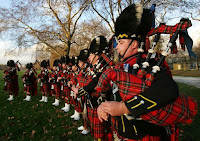A short time after the divorce of Henry VIII from Queen Catherine, living as a Catholic in England became a bit of a bother. The inconvenience was losing your estates, your properties, or your head, or all of the above. As Catholics were repressed, their teachings went underground. One way of doing that was with teaching songs. One of these teaching songs was 12 Days Of Christmas.
You don't have to use up all of your common sense in guessing that birds, rings and a lot of weird people weren't the subject of the teaching song. They stood there symbolically, but what did they symbolize? For Catholic children at the time, the song helped remember the content. Having a catchy tune, the song spilled out and became a Christmas carol. And most people have no clue what they are singing about. Let's have a look, starting with the first day of Christmas, or the 25th of December.
A partridge in a pear tree is offered for Christmas; the partridge is supposedly the only bird that will rather die than give up its young ones; the pear tree is a symbol of motherhood, while the pear stands for eternal life. Together, all these symbols represent Jesus Christ being born to give up his life for humanity.
Two turtledoves are the next offering for Boxing Day or the day of Saint Stephen, the first martyr. Harking back to Leviticus 12:8 where two of them replaced a lamb for offering, they are also the sacrifice Mary and Joseph offer in Jerusalem for Jesus's birth. In the teaching song, they symbolize the Old and the New Testament as the foundation of the Christian faith. There is no mention of any stipulation that allows so called Christians to cherry pick what they like and what to ignore. This would men that the whole Bible is meant including the parts that were edited out and are now called apocryphal.
Three French hens come as presents on the day of Saint John the Baptist and Saint John the Apostle. The three birds help to memorize faith, hope, and love as explained in 1 Corinthians 13.
Four calling birds are gifted on the day of Saint Anthony the Hermit; the stand in for the four 'official' gospels that made it into the Bible story collection, attributed to John, Luke, Mark, and Matthew.
Five gold rings are given on the day of Saint Thomas Becket. They symbolize the first five books of the Old Testament, also known as the Torah or the Pentateuch. The five books are reputedly written by Moses.
Six geese laying eggs are given away on the day of Saint Sabinus. They represent the six days God did some actual work creating the world. It doesn't answer the chicken or egg first question, though.
Seven swimming swans are the gift for the day of Saint Sylvester or New Years Eve. They represent the seven gifts of the Holy Spirit: Wisdom, Understanding, Counsel, Fortitude, Knowledge, Piety, Fear of the Lord. That the swans belong to the monarch is a nice irony to be treasured.
Eight maids milking cows or something stand in for the eight blessings Jesus preached on the mountain. They come as a gift on the day of Saint Mary the Virgin or New Year. the blessings or beatitudes are the poor in spirit, those who mourn, the meek, those that hunger for righteousness, the merciful, the pure at heart, the peacemakers, and the persecuted.
Nine dancing ladies skip in on the day of Saint Berta. They represent the fruit of the Spirit (that is not the one from the corner shop): Love, joy, peace, patience, kindness, generosity, faithfulness, gentleness, and self-control.
Ten lords follow the ladies on the day of Saint Genevieve. Lords were not only laying the law, they were also judging it. If ten brings to mind the ten commandments, and that is what it is, then logic wins out. I'm following Saint Augustine in this one, as his ideas have superseded any earlier ones and would have been the ones the Tudors thought were relevant: One God and no other, no swearing, Sunday is off, be nice to mom and dad, no killing, no adultery, no stealing, no fake news, no ogling your neighbors, no envy for what they have.
Eleven pipers making noise come in on the day of Saint Abraham. This again is against Jesus wishes, but only eleven Apostles are counted, Andrew, Bartholomew, the two James, John, Jude, Matthew, Matthias, Philip, the two Simon, and Thomas; Judas is excluded, despite the fact that without him, nothing would have happened as it should.
Twelve drummers drumming up a racket arrive on the day of the Martyrs of Egypt. They represent the twelve points of doctrine in the Apostles' Creed: God Father, Jesus Christ, Virgin Birth, Death, Resurrection, Ascension, Judgement Day, Holy Spirit, Catholic Church and Communion of Saints, Forgiveness of Sins, Resurrection of the Body, Life Everlasting. If you think it squeaks, it does, but twelve is such a nice number.
Having brought the twelve days of Christmas behind us, the next day is Epiphany, the day of the three Magi, or of three Holy Kings Balthasar, Caspar, and Melchior. Learning and repeating all the stuff in the song was a preparation for this very holy day; before bakers started making money from it.
Further reading
Epiphany and the three Magi
Saint Befana the Witch
The Shrine of the Magi















No comments:
Post a Comment